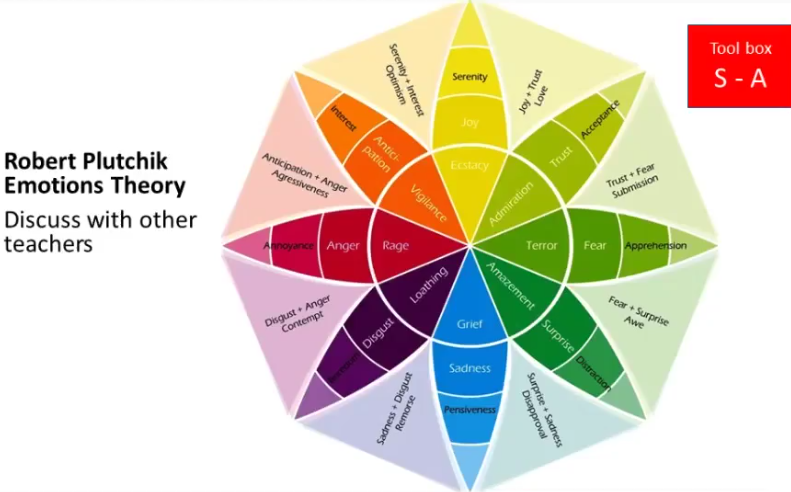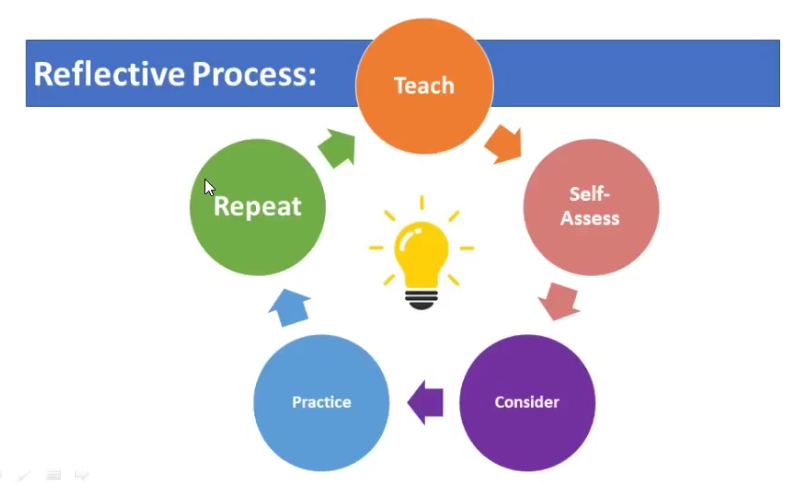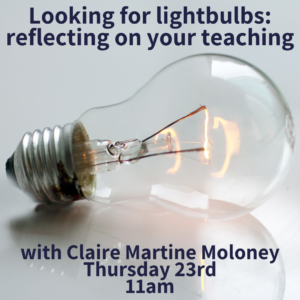Is your brain in sync with your heart when you’re in the classroom? This is Claire‘s aim in the session today and she started out by sharing a quote from John Dewey: “We do not learn from experience…we learn from reflecting on experience.”
As teachers, we all have a toolbox, whether it’s practical activities or techniques and Claire started by sharing our Emotional Intelligence (EQ) toolbox. This is divided into different parts – our self-awareness, self-management, social awareness and relationship management. She started out by talking about self-awareness and why it’s important to recognise why we do what we do, both in life and in the classroom. She highlighted how it’s useful to reflect on what we do well in the classroom (where our strengths lie) and also to be honest, rather than critical, about the areas we need to improve in. In terms of our professional development, self-reflection on our reactions to situations in the classroom can help us develop our self-awareness. Another aspect of self-awareness to be cautious of is how our relationships with learners are affected by how we perceive those learners. She also suggests being aware of our own emotional baggage, journalling our emotions and revisiting moments of difficulty and visualising how we would have preferred to respond.
Claire then showed the image below, Robert Plutchik’s Emotions Theory, highlighting that it can be useful to work on the wheel with learners to help them communicate their emotions better, but also to reflect on our own emotions and discuss how we are feeling with colleagues.

Knowing what the emotions we’re feeling are, helps us to manage them better, which leads into our self-management.
Claire shared an interesting idea called the window of tolerance, when our body is in its optimal state. However, there are areas outside the window of tolerance; hyperarousal – when we can’t calm down – and hypoarousal – when we shut down. Learning ourselves how to stay within the window of tolerance better enables us to pass on these self-regulation techniques to our learners.
Some other suggestions she shared to help with self-management are the following two videos, Safe Place Visualisation and Alan Watkins TED Talk, Why you feel what you feel.
Another thing which she says works well is to practise dealing with stress when you’re NOT stressed, so you have the necessary tools when you need them.
Moving on to social awareness, it’s important to listen actively to our learners and colleagues as we often have quick bursts of communication with the people around us, but may not be able to remember that short conversation if asked about it later. She suggests that we take notes for important conversations as well. She also talked about our body language, both in the in-person classroom and online and gave some suggestions for how we can communicate more to our learners through our body language in the online classroom – looking directly at the camera, nodding, waving to signify the end of the lesson, and so on.
One final aspect of our EQ toolkit is relationship management and a key point here is Mary Ainsworth’s Attachment Theory – how we relate to others in different contexts. Claire also talked about how we can take on the role of both mentor or mentee, for example, when we ask our colleagues for help with a challenging class or reach out to provide support to others. She also shared a visual for dealing with conflict and our reaction to it – avoiding, compromising, accommodating, collaborating or competing.
Now that we have our toolbox, she moved on to talk about being more reflective. This is a continuous process, as can be seen from the image on the right. However, we often get into automatic mode when we’re teaching, rather than actively going through the process of reflection. Claire highlighted that teachers who get into automatic mode are likely to suffer from burnout as they won’t feel like they’re developing.
Some ideas for working on your reflection include keeping a teaching diary (Claire shared some guiding questions from the British Council that you can use to reflect) and peer observation (including ideas such as identifying a focus question or looking for specific data through scripting, tracking and counting).
She talked as well about the different phases of reflective development. For example, in the initial stage, we tend to do more formal, planned and explicitly structured reflection; as we move through the developing phase, we have more tools at our disposal for reflection and an increased confidence in what we are doing and how we are reflecting on our practice; finally, in the advanced phase, our reflection is more seamlessly integrated into our practice and we feel able to mentor others through the process.

Claire finished with some Amazing Activities which we can use when we observe our teaching and reflect on our practice:
- the ratio of interaction
Through counting or tracking, you can assess the interactions you have with individuals, and the interactions they have with each other. Identifying your goals for these interactions before the lesson – taking into account the class size, level and objectives – can help you to later reflect. - growth mindset or fixed mindset
Which do you facilitate in your classroom? And how do you move learners from a fixed to a growth mindset? Check out Carol Dweck’s talk if you’re not familiar with these terms. Claire talked about how our approach to error correction or competitiveness might be facilitating a fixed mindset in our learners. - consistent corrections
This is not only related to how we correct our learners’ language, but also how we deal with behaviour in a consistent way. - opportunities to respond
Claire talked about promoting different ways to respond to learners in the lesson, such as using response cards or nominating individually. - type and level of questions
Track whether you’re asking enough open-ended questions, or questions which help learners develop their critical thinking skills - instructional vs. non-instructional time
How much of the time in the lesson was useful? This will obviously vary depending on the age and level of the learners, but tracking what’s happening throughout the lesson can help you better reflect on a number of aspects: time it takes to settle, time for routines, time devoted to giving instructions, and so on. - teacher talk vs. student talk
Related to the idea above is a reflection on who is communicating more during the lesson and how learners can do some of the teacher talk (for example, encouraging other to respond if a learner asks for repetition or clarification).

1 thought on “Looking for lightbulbs: reflecting on your teaching – with Claire Martine Moloney”